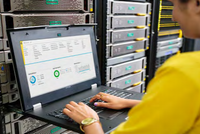- Community Home
- >
- Servers and Operating Systems
- >
- Servers & Systems: The Right Compute
- >
- KVM vs. Crash Cart: What’s it worth for reliable a...
Categories
Company
Local Language
Forums
Discussions
Forums
- Data Protection and Retention
- Entry Storage Systems
- Legacy
- Midrange and Enterprise Storage
- Storage Networking
- HPE Nimble Storage
Discussions
Forums
Discussions
Discussions
Discussions
Forums
Discussions
Discussion Boards
Discussion Boards
Discussion Boards
Discussion Boards
- BladeSystem Infrastructure and Application Solutions
- Appliance Servers
- Alpha Servers
- BackOffice Products
- Internet Products
- HPE 9000 and HPE e3000 Servers
- Networking
- Netservers
- Secure OS Software for Linux
- Server Management (Insight Manager 7)
- Windows Server 2003
- Operating System - Tru64 Unix
- ProLiant Deployment and Provisioning
- Linux-Based Community / Regional
- Microsoft System Center Integration
Discussion Boards
Discussion Boards
Discussion Boards
Discussion Boards
Discussion Boards
Discussion Boards
Discussion Boards
Discussion Boards
Discussion Boards
Discussion Boards
Discussion Boards
Discussion Boards
Discussion Boards
Discussion Boards
Discussion Boards
Discussion Boards
Discussion Boards
Discussion Boards
Discussion Boards
Discussion Boards
Community
Resources
Forums
Blogs
- Subscribe to RSS Feed
- Mark as New
- Mark as Read
- Bookmark
- Receive email notifications
- Printer Friendly Page
- Report Inappropriate Content
KVM vs. Crash Cart: What’s it worth for reliable access to your IT equipment?
Concerned about data center crash cart costs in terms of quick access to IT equipment and minimized downtime? Learn how IT Management from HPE provides a safety net when it comes compute environment control control and access.

Ahhh, but to quote Shakespeare, “therein lies the rub.” How many crash carts does it take (no joke intended) to provide the level of accessibility that most CTOs demand? As you expand the data center, should you also build a special room to house all the crash carts you will need to feel safe? Just how quickly can you access your servers using a crash cart? After all, time is money. Oh, and let’s not forget the maintenance and upkeep you will need for those laptops strapped to your crash carts. There’s software updates, replacing batteries, security measures to keep them from leaving the building, and the list goes on.
Why not consider the simpler, more reliable solution than a crash cart: a KVM Console Switch?
Since the introduction of the modern server, KVM switches have provided reliable access to all types of servers and IT equipment. Accessing up to 32 servers per switch and tierin
Right now, you’re thinking: “But how much will deploying KVM switches in each rack cost me?” The answer is more than the cost of a crash cart and less than one hour of downtime in your data center. Now factor in KVM maintenance which consists of the occasional firmware upgrade over a service life of 10+ years. Add it up and you should have no doubts about the value of KVM.
Learn more about IT management and rack and power infrastructure.
Featured articles:
- Management guide: IoT and the data center
- Data centers are here to stay, but see what is changing
- Hybrid IT in the software-defined data center
- Want to know the future of technology? Sign up for weekly insights and resources
Meet
With a passion for solving customer needs, Thai is committed to delivering compelling solutions to the market place. Thai Nguyen leads both the Worldwide HPE Server Networking, and HPE Rack and Power Infrastructure teams for the development and delivery for product management, go-to-market strategies and marketing programs.
- Back to Blog
- Newer Article
- Older Article
- PerryS on: Explore key updates and enhancements for HPE OneVi...
- Dale Brown on: Going beyond large language models with smart appl...
- alimohammadi on: How to choose the right HPE ProLiant Gen11 AMD ser...
- ComputeExperts on: Did you know that liquid cooling is currently avai...
- Jams_C_Servers on: If you’re not using Compute Ops Management yet, yo...
- AmitSharmaAPJ on: HPE servers and AMD EPYC™ 9004X CPUs accelerate te...
- AmandaC1 on: HPE Superdome Flex family earns highest availabili...
- ComputeExperts on: New release: What you need to know about HPE OneVi...
- JimLoi on: 5 things to consider before moving mission-critica...
- Jim Loiacono on: Confused with RISE with SAP S/4HANA options? Let m...
-
COMPOSABLE
77 -
CORE AND EDGE COMPUTE
146 -
CORE COMPUTE
155 -
HPC & SUPERCOMPUTING
138 -
Mission Critical
87 -
SMB
169

